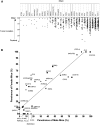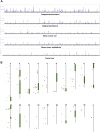A New Polygenic Model for Nonfamilial Colorectal Cancer Inheritance Based on the Genetic Architecture of the Azoxymethane-Induced Mouse Model
- PMID: 31879319
- PMCID: PMC7054011
- DOI: 10.1534/genetics.119.302833
A New Polygenic Model for Nonfamilial Colorectal Cancer Inheritance Based on the Genetic Architecture of the Azoxymethane-Induced Mouse Model
Abstract
The azoxymethane model of colorectal cancer (CRC) was used to gain insights into the genetic heterogeneity of nonfamilial CRC. We observed significant differences in susceptibility parameters across 40 mouse inbred strains, with 6 new and 18 of 24 previously identified mouse CRC modifier alleles detected using genome-wide association analysis. Tumor incidence varied in F1 as well as intercrosses and backcrosses between resistant and susceptible strains. Analysis of inheritance patterns indicates that resistance to CRC development is inherited as a dominant characteristic genome-wide, and that susceptibility appears to occur in individuals lacking a large-effect, or sufficient numbers of small-effect, polygenic resistance alleles. Our results suggest a new polygenic model for inheritance of nonfamilial CRC, and that genetic studies in humans aimed at identifying individuals with elevated susceptibility should be pursued through the lens of absence of dominant resistance alleles rather than for the presence of susceptibility alleles.
Keywords: cancer susceptibility; genetic architecture; heterogeneity; mouse models.
Copyright © 2020 by the Genetics Society of America.
Figures





Similar articles
-
A two-locus system controls susceptibility to colitis-associated colon cancer in mice.Oncotarget. 2010 Oct;1(6):436-446. doi: 10.18632/oncotarget.177. Oncotarget. 2010. PMID: 21311099 Free PMC article.
-
Azoxymethane is a genetic background-dependent colorectal tumor initiator and promoter in mice: effects of dose, route, and diet.Toxicol Sci. 2005 Dec;88(2):340-5. doi: 10.1093/toxsci/kfi313. Epub 2005 Sep 8. Toxicol Sci. 2005. PMID: 16150884
-
Genetic control of susceptibility to carcinogen-induced colorectal cancer in mice: the Ccs3 and Ccs5 loci regulate different aspects of tumorigenesis.Cell Cycle. 2011 Jun 1;10(11):1739-49. doi: 10.4161/cc.10.11.15817. Epub 2011 Jun 1. Cell Cycle. 2011. PMID: 21543896
-
Polygenic risk prediction models for colorectal cancer: a systematic review.BMC Cancer. 2022 Jan 15;22(1):65. doi: 10.1186/s12885-021-09143-2. BMC Cancer. 2022. PMID: 35030997 Free PMC article.
-
Polygenic resistance to mouse pulmonary adenomas.Exp Lung Res. 2000 Dec;26(8):617-25. doi: 10.1080/01902140150216701. Exp Lung Res. 2000. PMID: 11195459 Review.
Cited by
-
Mapping of novel loci involved in lung and colon tumor susceptibility by the use of genetically selected mouse strains.Genes Immun. 2022 Feb;23(1):23-32. doi: 10.1038/s41435-021-00159-z. Epub 2021 Dec 29. Genes Immun. 2022. PMID: 34966170 Free PMC article.
-
Epithelial-specific ERBB3 deletion results in a genetic background-dependent increase in intestinal and colon polyps that is mediated by EGFR.PLoS Genet. 2021 Nov 29;17(11):e1009931. doi: 10.1371/journal.pgen.1009931. eCollection 2021 Nov. PLoS Genet. 2021. PMID: 34843459 Free PMC article.
-
Genetic and microbial determinants of azoxymethane-induced colorectal tumor susceptibility in Collaborative Cross mice and their implication in human cancer.Gut Microbes. 2024 Jan-Dec;16(1):2341647. doi: 10.1080/19490976.2024.2341647. Epub 2024 Apr 24. Gut Microbes. 2024. PMID: 38659246 Free PMC article.
References
-
- Angel J. M., and DiGiovanni J., 2018. Genetic determinants of cancer susceptibility, pp. 330–360 in Comprehensive toxicology, Ed. 3, edited by McQueen C. A., Elsevier Science, Oxford: 10.1016/B978-0-12-801238-3.65251-0 - DOI
-
- Angel J. M., Popova N., Lanko N., Turusov V. S., and DiGiovanni J., 2000. A locus that influences susceptibility to 1, 2-dimethylhydrazine-induced colon tumors maps to the distal end of mouse chromosome 3. Mol. Carcinog. 27: 47–54. 10.1002/(SICI)1098-2744(200001)27:1<47::AID-MC7>3.0.CO;2-7 - DOI - PubMed
Publication types
MeSH terms
Substances
Grants and funding
LinkOut - more resources
Full Text Sources
Medical

